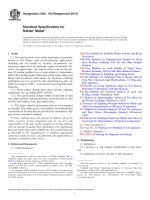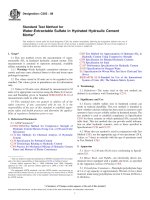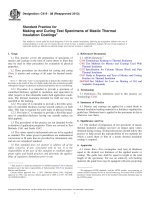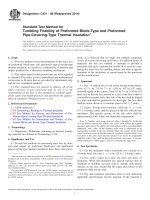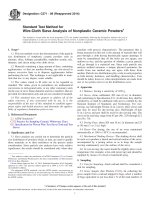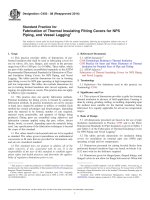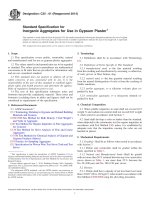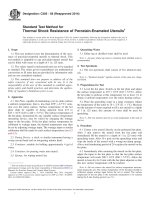Astm c 450 08 (2014)
Bạn đang xem bản rút gọn của tài liệu. Xem và tải ngay bản đầy đủ của tài liệu tại đây (55.18 KB, 2 trang )
Designation: C450 − 08 (Reapproved 2014)
Standard Practice for
Fabrication of Thermal Insulating Fitting Covers for NPS
Piping, and Vessel Lagging1
This standard is issued under the fixed designation C450; the number immediately following the designation indicates the year of
original adoption or, in the case of revision, the year of last revision. A number in parentheses indicates the year of last reapproval. A
superscript epsilon (´) indicates an editorial change since the last revision or reapproval.
2. Referenced Documents
1. Scope
2.1 ASTM Standards:2
C168 Terminology Relating to Thermal Insulation
C585 Practice for Inner and Outer Diameters of Thermal
Insulation for Nominal Sizes of Pipe and Tubing
2.2 ASTM Adjuncts:3
Fabrication of Thermal Insulating Covers for NPS Piping
and Vessel Lagging
1.1 This practice provides tables of dimensions of preformed insulation that shall be used in fabricating covers for
use on valves, ells, tees, flanges, and vessels in the pressure
range from 150 to 1500 psi (1 to 10 MPa). These tables, which
are part of this standard, are published separately as the ASTM
Recommended Dimensional Standards for Fabrication of Thermal Insulation Fitting Covers for NPS Piping, and Vessel
Lagging. The tables provide dimensions for use in forming
pipe fitting covers for NPS pipe operating at high temperature
and low temperature. The tables also include dimensions for
use in forming thermal insulation into curved segments, and
lagging, for application on vessels. This practice does not apply
to reflective-type insulation.
3. Terminology
3.1 Definitions—For definitions used in this practice see
Terminology C168.
4. Significance and Use
4.1 This system of dimensions provides a guide for forming
thermal insulation in advance of field application. Forming is
done by cutting, grinding, milling, or molding, depending upon
the method most suitable for the thermal insulation being
fabricated. It is equally applicable for all service temperature
ranges.
1.2 This practice does not specify fabrication methods.
Thermal insulation for fitting covers is formed by numerous
fabrication methods. In general, insulations are cut by circular
or band saws, shaped by grinders or millers, or molded. Each
method has certain advantages and disadvantages, depending
upon the material to be formed, number of cuts required,
material waste permissible, and quantity of fittings being
produced. Fitting parts are assembled using adhesives and
fabrication cements applied using dip pots, rollers, doctor
blades, brush, or trowel, depending upon the materials being
used. Any specification of the fabrication techniques is beyond
the scope of this standard.
5. Basis of Design
5.1 All dimensions presented are based on the use of pipe
insulation manufactured to Practice C585 and to the Basic
Dimensional Standards for Pipe Insulation as given in Tables 1
and Tables 2 of the Fabrication of Thermal Insulating Covers
for NPS Piping and Vessel Lagging.3
1.3 The values stated in inch-pound units are to be regarded
as standard. The values given in parentheses are mathematical
conversions to SI units that are provided for information only
and are not considered standard.
1.4 This standard does not purport to address all of the
safety concerns, if any, associated with its use. It is the
responsibility of the user of this standard to establish appropriate safety and health practices and determine the applicability of regulatory limitations prior to use.
5.2 The tables provide dimensions for insulation fitting
covers for installation on nominal pipe size (NPS) pipe
operating at high and low temperatures.
5.3 Dimensions presented for cutting beveled blocks from
preformed thermal insulation (lags) are based on blocks 6 in.
(152 mm) wide by the thickness required.
5.4 Dimensions given for flanged pairs, flanged fittings, and
flanged valves do not allow for flange bolt removal. When bolt
1
This practice is under the jurisdiction of ASTM Committee C16 on Thermal
Insulation and is the direct responsibility of Subcommittee C16.20 on Homogeneous
Inorganic Thermal Insulations.
Current edition approved April 1, 2014. Published April 2014. Originally
approved in 1960. Last previous edition approved in 2008 as C450 – 08. DOI:
10.1520/C0450-08R14.
2
For referenced ASTM standards, visit the ASTM website, www.astm.org, or
contact ASTM Customer Service at For Annual Book of ASTM
Standards volume information, refer to the standard’s Document Summary page on
the ASTM website.
3
Available from ASTM International Headquarters. Order Adjunct No.
ADJC0450A. Original adjunct produced in 1976. Adjunct last revised in 2002.
Copyright © ASTM International, 100 Barr Harbor Drive, PO Box C700, West Conshohocken, PA 19428-2959. United States
1
C450 − 08 (2014)
removal is required, the covering length over the flange shall
be increased as specified by the purchaser.
7. Assembly and Tolerances
7.1 All formed pieces shall fit tightly together so that both
sides and length of the insulation joint can close within a
maximum of 1⁄16 in. (1.6 mm).
6. Fabrication
6.1 Any method of forming may be used if the resulting
fitting conforms to inside and outside the dimensions listed.
6.2 The main body of the insulation fitting shall be cut from
standard pipe size pipe covering of the proper size and
thickness.
6.3 Where only one insulation type is required, and is
available in sufficient thickness, multiple layers are not required.
6.4 Where two insulations of different temperature ratings
are required, each insulation type shall be assembled in its
proper location in the fitting using double layer construction.
6.5 Flat block, cut to proper curvature, may be used in place
of preformed pipe insulation. The user shall be informed when
a change, for example, supplying a fabricated product instead
of a molded or preformed pipe insulation, that may cause
differences in the thermal or mechanical performance characteristics of the end product.
6.6 Where the body of the flange cover extends over
adjacent pipe insulation, the portion of the cover shall be
fabricated using the pipe insulation as the body and adding an
insert collar. Another method, which has been used, is by
adding an insert or section, commonly called a “dutchman,”
made of block.
6.7 Valves manufactured by various companies for the same
pressure and nominal pipe size may not have the same bonnet
dimensions, or height of bonnet flange above centerline of
valve. Because of this, the valve insulation is designed to fit the
largest valve of a size, type, and pressure. In some instances,
additional insulation may be required to fill or build up the
insulation for proper fitting around the bonnet. In other
instances it may be necessary to cut back insulation around the
bonnet to provide access to the packing gland. Cutout for hand
wheel assembly and packing gland should be done at time of
application.
7.2 Low-temperature pipe insulation fabricated from block
or board stock shall contain no more than four cemented
“through” joints per full section of insulation, excluding the
half section mating plane.
7.3 Finished pieces shall be identified using tags, attached
strip, etc. for ease of field installation.
7.4 The inner and outer surface of vessel insulation sections
shall be concentric with the outer surface. The deviation from
concentricity shall not exceed 3⁄16 in. (5 mm).
7.5 Material (glue, adhesives, etc.) used in the fabrication of
fitting covers shall be those recommended by the manufacturer
for the specific application and exposure conditions.
8. Field Application Sequence
8.1 Insulation coverings for welded or screwed fittings
should be applied before the pipe insulation.
8.2 Pipe insulation should be installed up to all flanges,
flanged fittings, and flanged valves. Provide sufficient space for
future bolt removal where required.
8.3 Covers for flanges, flanged fittings, and flanged valves
should be installed so as to extend, not less than specified
thickness, over adjacent pipe insulation or minimum 2 in.
(50mm).
8.4 Where required, the junction between the pipe insulation and flanged fittings covers can, by use of non-setting
cements, sealents or other methods, also serve as an expansion
or contraction joint.
9. Keywords
9.1 dimensions; thermal insulating materials; thermal insulating materials—fabrication; thermal insulating materials—
fittings; thermal insulating materials—pipe
ASTM International takes no position respecting the validity of any patent rights asserted in connection with any item mentioned
in this standard. Users of this standard are expressly advised that determination of the validity of any such patent rights, and the risk
of infringement of such rights, are entirely their own responsibility.
This standard is subject to revision at any time by the responsible technical committee and must be reviewed every five years and
if not revised, either reapproved or withdrawn. Your comments are invited either for revision of this standard or for additional standards
and should be addressed to ASTM International Headquarters. Your comments will receive careful consideration at a meeting of the
responsible technical committee, which you may attend. If you feel that your comments have not received a fair hearing you should
make your views known to the ASTM Committee on Standards, at the address shown below.
This standard is copyrighted by ASTM International, 100 Barr Harbor Drive, PO Box C700, West Conshohocken, PA 19428-2959,
United States. Individual reprints (single or multiple copies) of this standard may be obtained by contacting ASTM at the above
address or at 610-832-9585 (phone), 610-832-9555 (fax), or (e-mail); or through the ASTM website
(www.astm.org). Permission rights to photocopy the standard may also be secured from the ASTM website (www.astm.org/
COPYRIGHT/).
2
